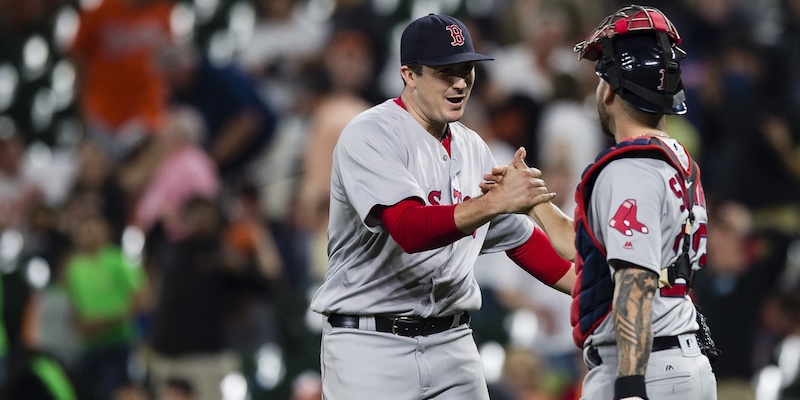When the Red Sox acquired Carson Smith from the Mariners following the 2015 season, it looked like a savvy move to significantly strengthen the back-end of the bullpen. Smith was coming off a breakout season in Seattle in which he was at or near the top in many statistics on the relief pitching leaderboards. Smith has a bit of a funky delivery from which he unleashes a low-to-mid-90s fastball and frisbee slider that make life difficult for opposing batters. Unfortunately, the funky delivery may have precipitated the elbow injury that required him to go under the knife for Tommy John Surgery and sit out the majority of the 2016 and 2017 seasons. Of course, his delivery may not be the direct cause of the injury. It could be that Carson Smith is a pitcher and most pitchers’ arms explode eventually. Therefore, Carson Smith’s arm was likely to explode. A sad syllogism for this wonderful sport.
Regardless of the exact root of Smith’s injury, it has limited him to only 10.2 major league innings in a Red Sox uniform: 2.2 in May, 2016, 6.2 in September, 2017, 1.1 in October, 2017 (postseason). As such, he is still something of a mystery for the 2018 roster. It is difficult to anticipate how any pitcher will respond to Tommy John Surgery; Smith is no exception. Will he regain his 2015 form? Can he maintain it for a whole season? Across multiple seasons? This last question can wait for now, but, even with the uncertainty that surrounds Smith, he is likely to enter the 2018 season as one of the Red Sox’s two primary setup men in front of Craig Kimbrel. That is an important role for a guy who hasn’t really played in two years.
WHAT WENT RIGHT
There is not a lot to say about a guy who didn’t play very much, but it is worth noting that in his few innings, Smith was solid. He allowed only one run, struck out a little over a quarter of the batters he faced, and generally had both of his pitches working.
But the important part of his 2017 is that he got back on the field. Over the last decade or so, the number of pitchers requiring Tommy John Surgery and the success rate of the surgery has pushed us to dismiss (or at least ignore) the difficulty involved in returning to pitch in the major leagues after the procedure. When news breaks that a guy is putting his elbow under the knife, we take for granted he will be gone from the team for 18-ish months and then return ready to go, maybe even throwing harder than before the surgery. I know I’m guilty of this, as there were many days on which I advised David Price from my couch to get the surgery ‘over with’. Over with? What a ridiculous thing to suggest. While the success rate is high, it is not a magical guarantee. The player has to work hard, physically and mentally, just to get back, let alone perform well. The good news is that Smith checked both of those boxes in 2017, which must give him confidence for 2018.
WHAT WENT WRONG
To pick a nit – and immediately descend from the high horse I climbed on in the previous section – it did take Smith longer than anticipated to get back on the field this year. This is not necessarily a bad thing. I am no proponent of rushing player’s back from injury, but his rehab taking longer than expected can be classified as something that went wrong for him last year. He had a setback or two during his recovery and missed the expected return of late July/early August by about six weeks.
I suppose it is worth mentioning that while Smith pitched well in his eight appearances during the regular season, his two appearances in the ALDS were less than stellar. In Game Two he relieved Drew Pomeranz in the bottom of the third, walked the first two batters he faced before Josh Reddick hit a 93mph rocket at Deven Marrero for the first out of the inning. That was the end of Smith’s day. In Game Three he got the ball in the ninth inning with the Red Sox leading 10-3. He gave up two singles (only one of which was hit well), but induced a double-play and struck out Carlos Correa to end the game. It was not a terrible outing, but it was not clean and definitely not the sort of thing you want to see from one of the team’s to-be premier relievers. But again, this is mostly picking a nit. I’m not really worried that his 1.1 postseason innings were imperfect.
WHAT TO EXPECT
It is pretty simple: to start the year, Smith will be slotted into a role at the backend of the bullpen. Along with Tyler Thornburg and Craig Kimbrel, Smith will form Alex Cora’s primary trio of high-leverage relievers. On paper that is formidable, but the question marks looming over Smith and Thornburg leave us in an uncomfortable wait-and-see situation. If Smith pitches well and Kimbrel needs to miss time, Smith could even grab the capital-C closer role – with the critical caveat that we don’t yet know how Cora will run the bullpen. I think it is also worth noting that this is the last year on Kimbrel’s contract. Kimbrel is an elite reliever, but I suspect the Red Sox will be hesitant to shell out what a then-31-year-old Kimbrel is going to demand in free agency. So with a strong 2018 season, Smith can push himself further along the inside track to the spotlight and money that come with finishing games for the Boston Red Sox.
Photo by Patrick McDermott – USA TODAY Sports
